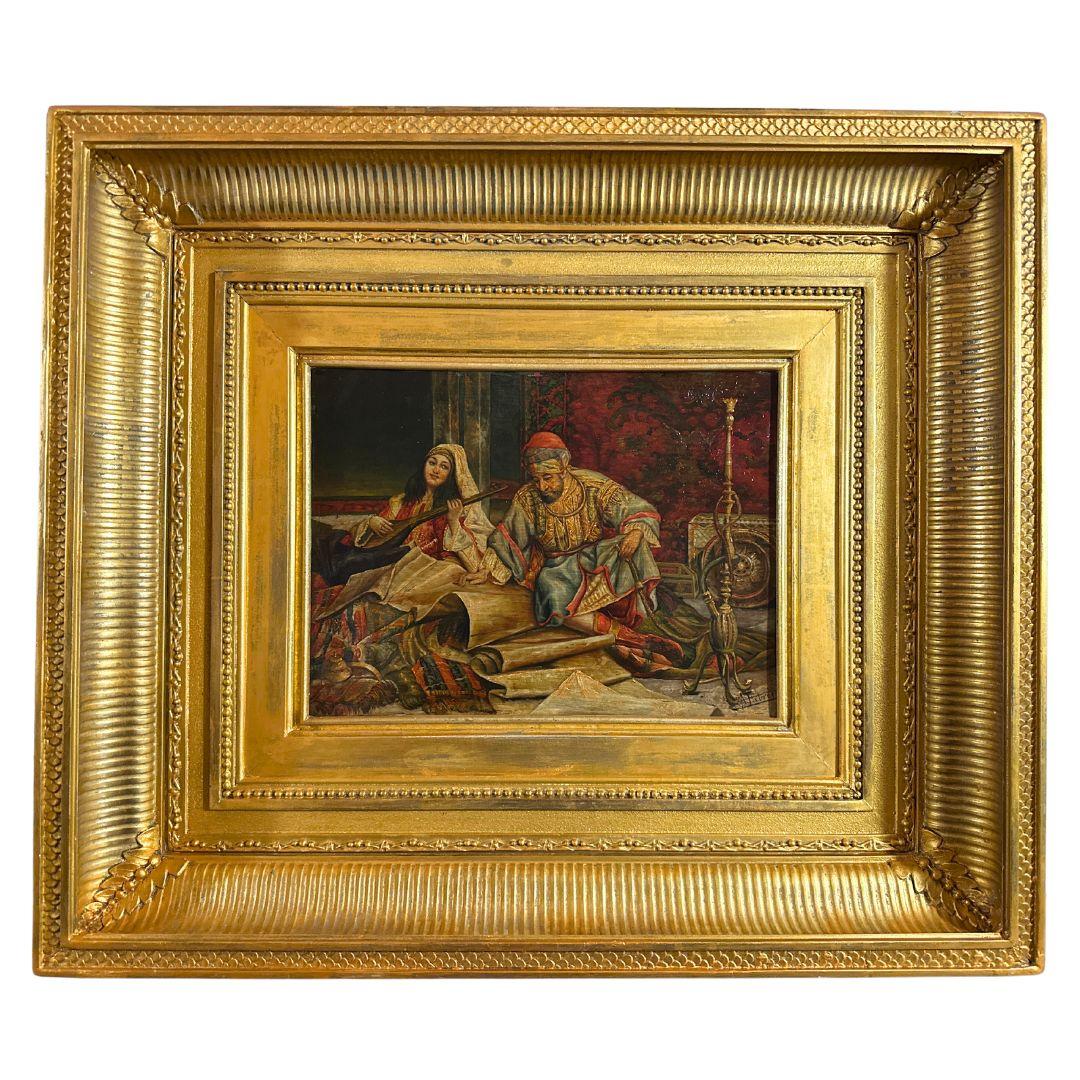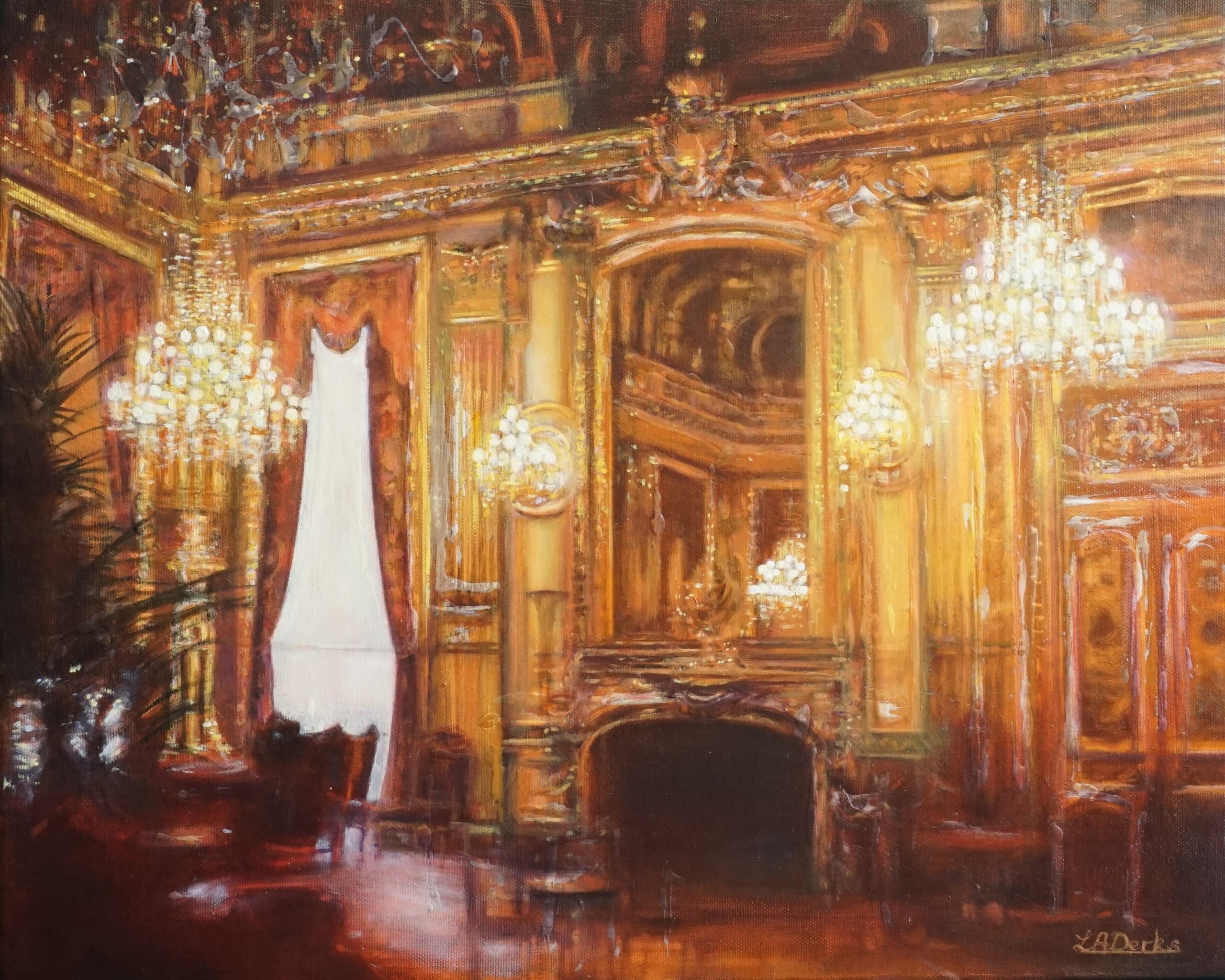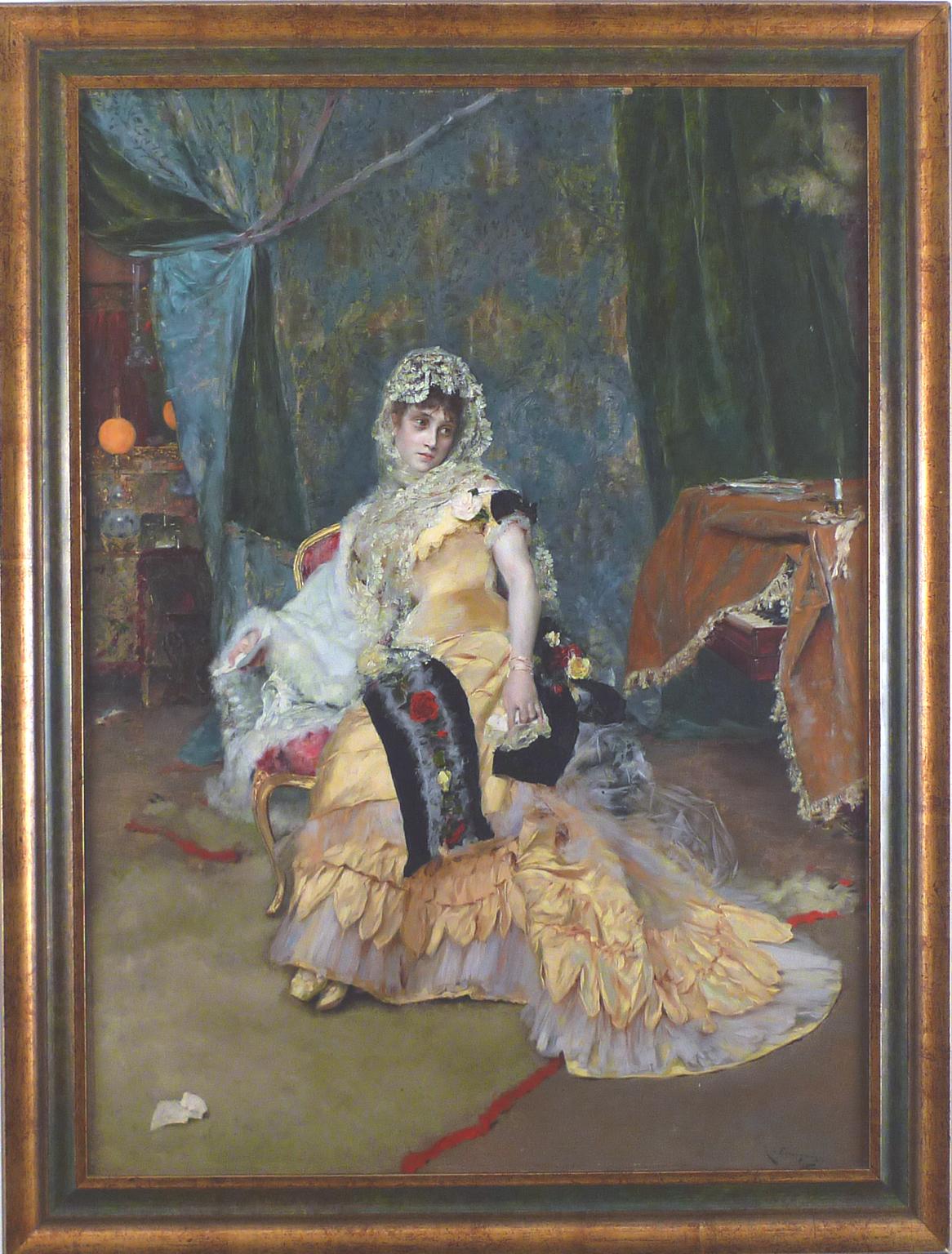Items Similar to 17th Century Genre Painting -- The Pipe Smoker
Want more images or videos?
Request additional images or videos from the seller
1 of 9
Flemish School, 17th Century17th Century Genre Painting -- The Pipe Smoker1750-90
1750-90
About the Item
Wonderful genre painting from 18th Century of pipe smoker. Signed lower right edge with monogram "I I E". Oil paint on copper. Condition: good: minor wear/rubbing from frame's rabbet. Presented in rustic frame of wood, gilt edge and linen fillet. Image size: 6.50"H x 5.30"W. Framed size: 11"h X 12"W.
- Creator:Flemish School, 17th Century (1600 - 1699)
- Creation Year:1750-90
- Dimensions:Height: 12 in (30.48 cm)Width: 11 in (27.94 cm)Depth: 1.25 in (3.18 cm)
- Medium:
- Movement & Style:
- Period:Mid-17th Century
- Condition:
- Gallery Location:Soquel, CA
- Reference Number:
About the Seller
4.9
Platinum Seller
These expertly vetted sellers are 1stDibs' most experienced sellers and are rated highest by our customers.
Established in 1986
1stDibs seller since 2014
2,526 sales on 1stDibs
Typical response time: <1 hour
- ShippingRetrieving quote...Ships From: Soquel, CA
- Return PolicyA return for this item may be initiated within 14 days of delivery.
More From This SellerView All
- "The Family Hearth" - Turn of the Century Cozy Interior Figurative SceneBy Charles Everett JohnsonLocated in Soquel, CACharming turn-of-20th Century interior painting that takes the viewer back to simpler times with grandmother, grandfather, mother sewing and a young girl playing with her greyhound a...Category
Early 1900s Realist Interior Paintings
MaterialsLinen, Oil
- A Jolly Time -- German Genre Tavern Painting, 1918Located in Soquel, CAWonderful German genre painting of 17th century tavern scene in style of Franz Hals by Karl Josef Muller (German, 1864-1942) dated 1918. Signed and dated lower left corner "Karl Muller - Hamburg 1918". Condition: Good; professionally restored: Canvas restreched on new stretcher bars; five repairs made to small tears in canvas (see image); cleaned and re-varnished with UV-resistant varnish. Unframed. Image size: 39.5"H x 55"W. We have the original frame which needs some extensive repair to the gesso. Happy to include the frame with the painting as is. Karl Müller was born in Hamburg-Altstadt in 1865. His wealthy Jewish parents Abraham Müller (1832-1896), citizen of the Hanseatic city since 1869, and Henriette "Jette", b. Burchard (born 1832 Neubuckow / Mecklenburg), had a cigar factory at Spielbudenplatz 5 in St.Pauli. When Karl Müller was ten years old, next to factory and warehouse, now at Speersort 11 (Altstadt), there was also a branch in Altona-Ottensen with the address Am Felde 68. The family lived at the time at Pferdemarkt 13 (Old Town). After attending the Jewish Foundation School at the Zeughausmarkt, Karl Müller completed a three-year lithography apprenticeship. From 1886 to 1888, he studied at the Royal Saxon School of Applied Arts in Dresden with the history and decoration painter Donadini, then with Professor Hanke of the Prussian Academy of Arts in Berlin. Karl Müller's painting style was conventional-realistic and did not follow modern trends. In 1891, the oil paintings "Preparation for the Service", "In the guardroom", tattoo", "gymnastics lesson", "covert patrol” and "return from the field service exercise”, whose main motive almost always soldiers formed.In 1893, he painted the" invasion of the 76er " as a horizontal format in black and white, the painting was acquired by the Museum of Hamburg History in 1930. The disposition of Karl Müller could be classified as "kaisertreu" and "national" (Maike Bruhns) at this time - not by chance he acted with his Nicknamed "Soldatenmüller", he successfully participated in exhibitions in Berlin and Hamburg before the turn of the century. Even at this time, the frequent change of residence is striking: 1893 Papendamm 25 (Rotherbaum), 1896 Bundesstraße 9 (Rotherbaum). In 1898 he was in the Hamburg address book as a "genre and portrait painter" with the residential address 1. average 43 (Rotherbaum) out. At the age of 38, Karl married in 1903 in the Hanseatic city of the Jewish Louise Hauer (born 12.2.1872 in Hamburg), called "Lieschen". Before her marriage, she lived with her mother at Grindelberg 78. Her father, Martin Hauer (1836-1897), also born in Hamburg and was a citizen of the city since 1862, owned a factory for soap and perfume. In 1904 and 1911, the two daughters Karla and Lotte were born. 1904, the family lived at this time in the Bogenstraße 20, Karl Müller commissioned a portrait of the emigrated hamburger Henry Jones opening the same lodge in the Hartungstraße 9-11. Already at this time he might have been a member of the Hamburg Artists Association of 1832. Starting from 1908 further change of dwellings on the basis of the telephone books are comprehensible: nearly yearly the family moved and moved thereby from the Grindel quarter over Hoheluft east to Harvestehude and Winterhude. Around 1912 she moved into an apartment in Sierichstraße 156. Here, the landlord Schröder provided the artist with an area of around 45 square meters as a studio on the dry floor. But the building police criticized this use and after some disputes, the painter had to move once again with family and studio. The official telephone directory recorded as an address from 1914 to 1918 Klosterallee 20 (Harvestehude). Friedrich Jansa described Karl Müller's changed motif choice in his artist's glossary in 1912: "In recent years he has been watercolouring a lot in the Hamburg area and now mainly takes his motifs from Hamburg harbor...Category
1910s Realist Interior Paintings
MaterialsLinen, Oil
- Rare Early 20th C. Watercolor -- Pendennis, Captain Costigan and Miss FotheringBy Charles Edmund BrockLocated in Soquel, CAAn fine period watercolor, dated 1910, an illustration by Charles Edmund Brock (English, 1870-1938). This, from a semi-autobiographical novel written by William Makepeace Thackeray, "Pendennis", in full "The History of Pendennis: His Fortunes and Misfortunes, His Friends and His Greatest Enemy." The novel was published in monthly installments from 1848 to 1850 and published in book form in two volumes in 1849–50. Below this image is a quote from "Pendennis," Chapter VI, "Captain Costigan leaves Pendennis & Miss Fotheringay at the great window looking out into the Deans Garden". Signed lower left. Displayed in a rustic giltwood frame. Image, 8.5"H x 6.25"W. Charles Edmund Brock was a widely published English painter, line artist and book illustrator, who signed most of his work C. E. Brock. He received his first book commission at the age of 20. He became very successful, and illustrated books for authors such as Jonathan Swift, William Thackeray, Jane Austen, Charles Dickens, and George Eliot. Brock also contributed pieces to several magazines such as The Quiver, The Strand, and Pearsons...Category
1910s Realist Figurative Paintings
MaterialsPaper, Watercolor
- Contemporary Large-Scale Cubist Figurative Abstract Lavender Interior SceneBy Michael William EgglestonLocated in Soquel, CAContemporary Large-Scale Cubist Figurative Abstract Lavender Interior Scene Bursting with bright colors and whimsical energy, this contemporary figurative abstract painting by San ...Category
Early 2000s Contemporary Figurative Paintings
MaterialsOil, Cardboard
- Mid Century Portrait Charlotte with FlowersBy Irina Belotelkin RoublonLocated in Soquel, CAWonderful mid century portrait of woman named Charlotte by Irinia Belotelkin Roublon (Russian/American, 1913 - 2009), circa 1960. Signed lower right corner and on verso. Unframed. Image size: 14"H x 11"W. Irina Belotelkin Roublon, née Roudakoff, was born in Elisavetgrad, Ukraine to the Russian noblesse ancienne, descendant of Catherine the Great, she was a student at the Mariinsky Noble Ladies' Institute , Novocherkassk, Russia. She was orphaned at the time of the Russian Civil War after her father, General Paul Roudakoff, was fatally wounded in battle; 5 days later her mother died of typhus. Still unaware of her parents' death, and after witnessing her two sisters' deaths from starvation, the young Irina, then 8 years old, made her way over 1,000 kilometers, alone and through many privations to Moscow and the Estonian embassy there, with whom her Estonian uncle Volodya Blonsky had made arrangements. After a year in Moscow, and appeals to the Estonian consul, Irina was aided in a dramatic escape from the Soviet Union, to her aunt Anna Blonsky Lassburg (1882–1940) and her husband Doctor Genrick Lassburg in Tallinn, Estonia. Eventually, after in 1929, traveling through Ellis Island and admitted as a student, of voice studies, she joined her brother who had settled, in 1923, in the United States. Irina came to San Francisco during the Second World War, Among Irina's devotions were ballet and opera. She often entertained friends Rudolf Nureyev, Mikhail Baryshnikov, and Sergei Leiferkus when they were in town. Natalia Makarova and Yuri Possokhov were often guests at Irina's Russian Christmas and Easter parties. From the early 1960s through the late 1980s, Irina studied and prolifically created still life and portrait paintings in oil and water color, excelling in flower compositions. She held studio and feature exhibitions; she competed and won prizes. Her work is in holdings throughout the San Francisco Bay area, Europe and Russia. In 1965 she undertook private study with two prominent Russian painters, including Serge Ivanoff; she executed a portrait of her two masters. She cherished her portrait as executed by Serge Ivanoff. Among her most accomplished pieces are those of iris and the large white Matilija...Category
1960s American Impressionist Figurative Paintings
MaterialsCanvas, Oil
- Dreaming in Color, Expressionist Reclining Female FigureLocated in Soquel, CAA vivid, multicolored expressionist depiction of a gracefully reclining female figure by Bay Area artist Rick Rodrigues (American, 20th Century). Signed with the artist's symbol lowe...Category
1980s Expressionist Figurative Paintings
MaterialsOil, Canvas
You May Also Like
- "Music in the Palace" 19th Century Orientalist Oil Painting on Copper, SignedLocated in Jacksonville, FLDescription: Antonio Maria Fabres (1854-1936) was a Spanish painter known for his exquisite artworks depicting historical and Orientalist themes. Born in Barcelona, Fabres displayed ...Category
19th Century Realist Figurative Paintings
MaterialsCopper
- Parisian Chandeliers, landscape art, original art, interior art, still-lifeLocated in Deddington, GBParisian Chandeliers by Lesley Ann Derks [2017] original Oil and enamel on canvas Image size: H:40 cm x W:50 cm Complete Size of Unframed Work: H:...Category
21st Century and Contemporary Realist Figurative Paintings
MaterialsEnamel
- Parisian ChandeliersLocated in Deddington, GBParisian Chandeliers by Lesley Ann Derks [2017] original Oil and enamel on canvas Image size: H:40 cm x W:50 cm Complete Size of Unframed Work: H:...Category
2010s Realist Figurative Paintings
MaterialsEnamel
- The Cardinal's VisitLocated in Madrid, ESSALVADOR SÁNCHEZ BARBUDO Spanish, 1857 - 1917 THE CARDINAL'S VISIT signed, located and dated "Barbudo / ROMA 1902" (lower right) oil on canvas 22 x 33-2/3 inches (55.5 x 85.5 cm.) ...Category
Early 1900s Realist Figurative Paintings
MaterialsCanvas, Oil
- "Lady in yellow", 19th Century oil on panel by Rogelio de Egusquiza y BarrenaBy Rogelio de Egusquiza y BarrenaLocated in Madrid, ESROGELIO DE EGUSQUIZA Y BARRENA LADY IN YELLOW signed "R. Egusquiza" (lower right) oil on panel 28-5/8 X 20-3/4 inches (72.5 X 52.7 cm.) framed: 32-5/8 X 24-3/4 inches (82.5 X 62.5 cm.) Rogelio de Egusquiza y Barrena (1845 – 10 February 1915) was a Spanish painter, known for his friendship with the German composer Richard Wagner, whose works he helped make familiar in Spain He was born in El Astillero, into a well-to-do family. He studied in Madrid and with Léon Bonnat at the École des Beaux-Arts in Paris. In 1868, after travelling and participating several times in the National Exhibition of Fine Arts, he returned to Paris and settled there. At first, he painted historical scenes, but later turned to genre scenes and portraits in the Academic style. Following the death of Marià Fortuny, he moved to Rome at the invitation of the Madrazos, Raimundo and Ricardo, taking Fortuny's place at their studio through 1875 and attending classes at the Spanish Academy in Rome. He heard Wagner's music for the first time in 1876, after returning to Paris. Three years later, he travelled to Munich to hear a performance of The Ring of the Nibelungen. His enthusiasm for what he heard led him to go to Bayreuth, where he introduced himself to Wagner and became his friend. In the following years, he and Wagner got together again several times; in Venice (1880), Berlín (1881) and Bayreuth (1882); where he was a guest at the premiere of Parsifal. After his first meeting with Wagner, he decided to devote his career to doing works on Wagnerian themes; mostly portraits of the characters rather than specific scenes. During his visits to Germany, he also created portraits of Arthur Schopenhauer (posthumous) and King Ludwig II...Category
1880s Realist Interior Paintings
MaterialsOil, Panel
- "Partida de Tresillo", Late 19th Century Oil on Canvas by José Jiménez ArandaLocated in Madrid, ESJOSÉ JIMÉNEZ ARANDA Spanish, 1837 - 1903 PARTIDA DE TRESILLO signed, located & dated “J. Aranda / Madrid. 1893.” (lower right) oil on canvas 31-1/2 x 39-1/3 inches (80 x 100 cm) framed: 40-1/3 x 48 inches (102.5 x 122 cm.) BIBLIOGRAPHY - This picture being mentioned and illustrated in “LA ILUSTRACION ESPAÑOLA Y AMERICANA”, Madrid, September 15, 1895 - José Jiménez Aranda, 1837-1903: Centro Cultural El Monte, Seville, October 2005, illustrated p. 102 PROVENANCE Private Collection, USA José Jiménez Aranda (7 February 1837 – 6 May 1903) was a Spanish painter and brother of the painters Luis Jiménez...Category
1890s Realist Figurative Paintings
MaterialsOil, Canvas
Recently Viewed
View AllMore Ways To Browse
12 Century
Paintings Of The 18th Century
Mid Century Wood Art Frame
Framed 17th Century
18th Century School
Flemish Paint
Flemish Paintings Century
Flemish Paintings
Flemish Frame
17th Century Gilt
Rustic Painting Frames
Rustic Painting Framed
Flemish Oil Painting
Flemish 17th
17th Century Flemish
Flemish 18th Century
Pipe Antique
Antique Flemish Oil Painting




